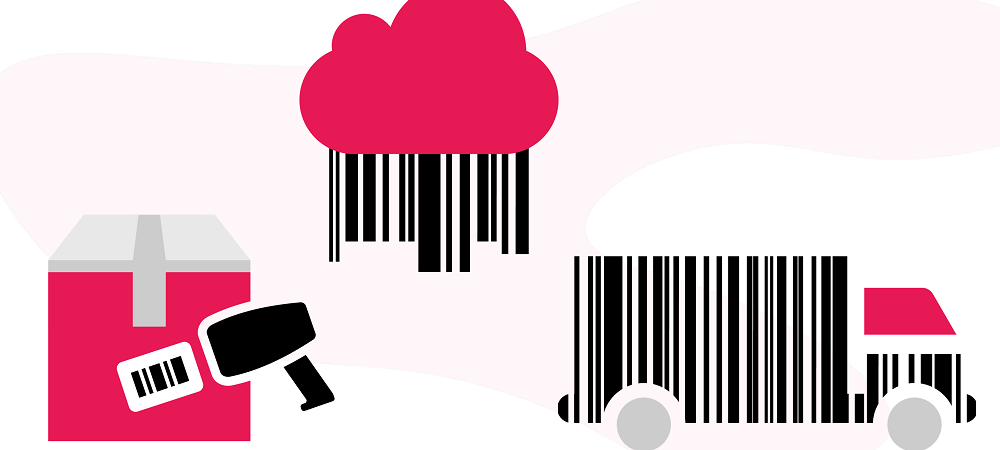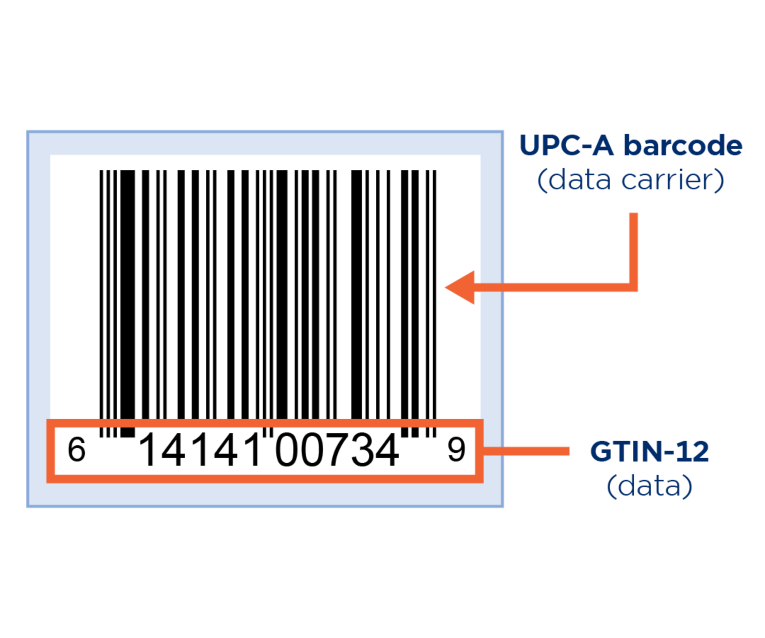
If you have an ecommerce website, plus an ERP, a PIM, or order management software, you will likely use one or more different codes to identify products throughout the supply chain, sales, and fulfillment process. Some are customer-facing and others exist only in the back-end. In this article we’ll cover what they all mean, how you get them and which you need for products you sell on Amazon.
The ‘official’ product code: UPC/GTIN
The Universal Product Code (UPC) is the barcode that most countries use to track trade items in stores. Barcodes were introduced in 1974 and can be scanned electronically, enabling products to be easily tracked, processed, stored, and tills to be programmed with price information. The Global Trade Item Number (GTIN), is the number you see above / below the barcode which is contained in the barcode. It consists of 12-14 numeric digits (depending on location) uniquely assigned to each trade item.

A common misconception is that GTINs and UPCs are the same thing, and many people use the terms interchangeably. However, they are not the same thing. The GTIN is a unique identifier supported by standardized data and the UPC is the actual data carrying barcode. NOTE: The European Article Number (EAN) is the European equivalent of a UPC.
GS1, an international not-for-profit organization dedicated to developing and maintaining barcode standards, developed the GTIN and maintains a database containing product information belonging to retailers, manufacturers, collectors, researchers, or other entities.
A UPC barcode, together with a product’s GTIN make it easy for businesses to find, buy, trace, and fulfill. They are like fingerprints for your products and locations, giving everyone confidence that your products are uniquely identified along the supply chain.

GTINs and their importance to Amazon sellers
Amazon requires all products to have a GTIN because they help sellers prove that they are selling legitimate products and support inventory management. GTINs are so important to Amazon’s operations that as of 2023, Amazon enforces GTIN proof of ownership via GTIN ownership certificate before allowing you to list them on your products, and will hide product listings without a proper GTIN.
This is great news for sellers looking to combat counterfeiters, who while they can copy a GTIN, struggle to prove GTIN ownership.
Importantly, a different GTIN is required for every variation of your product – for all variations including, but not limited to, size, color, flavor, material, weight, and packaging quantity.
Where to Purchase a GTIN
GS1 US is the only reputable place to purchase GTINs for Amazon. Amazon sellers should avoid GTIN/UPC resellers, as their UPCs rarely work on Amazon because most are already in use or are hard to prove that you own them. They can also be difficult for you to sell.
Each GTIN license is $30 when purchased individually, but you can purchase a GS1 Company Prefix and then create your own GSINs in bulk. Either way, GSINs are entered automatically into the GS1 Global Registry and you receive a certificate of ownership.
Emplicit can walk clients through the GTIN purchase and product registration processes with GS1 and Amazon.
Amazon’s ASIN product code
The Amazon Standard Identification Number (ASIN) is a 10-character alphanumeric unique identifier assigned by Amazon and its partners for product identification within Amazon. Every product sold on Amazon has an ASIN, and it’s Amazon’s way to standardize its own records.
Here is a quick video that shows you where to find your products’ ASINs in various locations on the Amazon front-end. Your Emplicit Account Manager can show you where you can find ASINs in your Seller Central account.
Amazon’s FNSKU
The Fulfillment Network Stock Keeping Unit (FNSKU) is an Amazon-unique term describing the barcodes that help identify and track products and connect them to each seller. Amazon requires that sellers only have one barcode (if you have two it’s only a matter of time before you get flagged), so these labels are placed over the product’s UPC covering it or, sometimes, printed on products instead of a UPC. After an Amazon warehouse receives a product, its FNKSU goes on record. That way, if Amazon loses the product, the seller can recoup their costs.
Multiple sellers selling the same product will have a unique FNKSU for their inventory. This prevents a fulfillment center from combining the inventory of 2 or more sellers selling the same product (this is also referred to as non-commingled inventory). Refer to Seller Central for Amazon’s sizing and supporting information rules as it relates to FNSKUs.
In the example below, you’ll see the FNSKU requires: Brand Name – Product Name – Condition

Merchant SKU
A merchant SKU can be any string of numbers and letters referring to your product. They’re seller specific and used in your own reporting, product sales, and inventory management. Make these easily recognizable and/or have them match what your 3PL or warehouse uses to refer to the respective SKU. Being simple and understandable helps every party involved in the sales process, including customers, more easily communicate.
Solving product code issues
When a seller is listing products, Amazon ‘helpfully’ offers the ability to select EAN, UPC or GTIN. If your GTIN is 12 digits then select UPC, if your GTIN is 13 digits then select EAN, and if your GTIN is 14 digits then select GTIN.

If you get an error message during registration, then it can mean that there is a discrepancy between your registered seller information and the brand you are listing. Amazon will query whether you are authorized to sell the brand, and require a letter of authorization or an official invoice. Alternatively, you might be trying to list a product which is already listed – this can be because an alternate genuine (re)seller or a bad actor is already utilizing the code. Either way, if you can prove GTIN ownership the hijacked listing will become yours.
Best practice – have all product codes, but label with FNSKU
To sell through Amazon FBA, you must have at least one of the above unique identifiers printed or stickered on your product. Although all three (UPC/GTIN, ASIN, and merchant SKU) may exist for your products, you must only label your physical product with one. Emplicit recommends using the FNSKU because it’s the most secure way to protect your products.
Properly labeling products is critical, but ensuring Amazon has a consistent supply is a science and optimizing your listing and marketing is an art.

